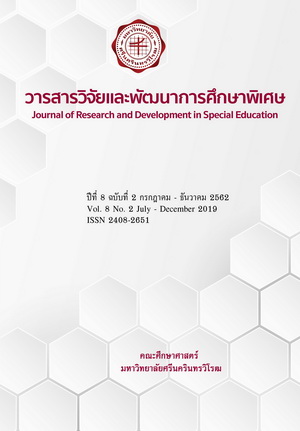การใช้แท็บเล็ตเพื่อพัฒนาการสื่อสารทางวาจาของนักเรียนที่มีภาวะออทิสซึมด้วยความร่วมมือของครูและผู้ปกครอง (USING TABLETS TO DEVELOP ORAL COMMUNICATION OF STUDENTS WITH AUTISM IN COLLABORATION OF TEACHERS AND PARENTS)
Abstract
บทคัดย่อการศึกษาครั้งนี้มีวัตถุประสงค์เพื่อ 1) สำรวจคำที่จำเป็นในการสื่อความหมายในชีวิตประจำวันของนักเรียนที่มีภาวะออทิสซึม สำหรับจัดทำบัตรภาพและนำภาพลงสู่แท็บเล็ต และ 2) ศึกษาผลการใช้ภาพแทนคำผ่านบัตรภาพและผ่านแท็บเล็ตเพื่อชี้แนะการสื่อสารด้วยวาจาให้กับนักเรียนที่มีภาวะออทิสซึมโดยครูและผู้ปกครอง ตัวอย่างวิจัยสุ่มแบบเจาะจง คือนักเรียนที่ได้รับการวินิจฉัยจากแพทย์ว่ามีภาวะออทิสซึมเพศชาย อายุระหว่าง 8-15 ปี จำนวน 3 คน กำลังศึกษาอยู่ในห้องเรียนขอบฟ้ากว้าง โรงเรียนเทศบาลวัดกลาง ใช้แบบวิจัยแบบกลุ่มตัวอย่างเดี่ยว แบบ A-B-C เครื่องมือที่ใช้ในการวิจัยได้แก่ แบบสำรวจคำเป็นแบบเติมคำ แผนการจัดการเรียนรู้ และแบบทดสอบความสามารถในการอ่านคำที่ใช้ในชีวิตประจำวันที่มีค่าความสอดคล้องระหว่างผู้สังเกตร้อยละ 95.67 วิเคราะห์ข้อมูลเป็นรายบุคคลและเป็นกลุ่ม และนำเสนอโดยใช้ภาพกราฟผลการศึกษาพบว่า 1) คำที่จำเป็นในการสื่อความหมายในชีวิตประจำวัน มี 40 คำ 2) ผลการใช้ภาพแทนคำผ่านบัตรคำและผ่านแท็บเล็ตของนักเรียนที่มีภาวะออทิสซึม 3 คนโดยครูและโดยผู้ปกครองในภาพรวมพบว่าในระยะเส้นฐาน (A) ค่าเฉลี่ยของจำนวนคำที่อ่านได้ เท่ากับ 5.67 คำ คิดเป็นร้อยละ 14.18 ระยะจัดกระทำ อ่านคำผ่านบัตรภาพที่นำเสนอโดยครู (B1) ค่าเฉลี่ยของจำนวนคำที่อ่านได้ เท่ากับ 34.2 คำคิดเป็นร้อยละ 85.5 อ่านคำผ่านแท็บเล็ตที่นำเสนอโดยครู (B2) ค่าเฉลี่ยของจำนวนคำที่อ่านได้ เท่ากับ 38.11คำ คิดเป็นร้อยละ 95.28 อ่านคำผ่านแท็บเล็ตที่นำเสนอโดยผู้ปกครอง (C) ค่าเฉลี่ยของจำนวนคำที่อ่านได้เท่ากับ 38.89 คำ คิดเป็นร้อยละ 97.23 และหลังฝึกพบว่าตัวอย่างวิจัยสามารถอ่านคำได้มากขึ้น อ่านคำเสียงดังและชัดเจนขึ้น มีความมั่นใจในการอ่านคำ และสามารถใช้คำเหล่านั้นบอกความต้องการได้ ABSTRACTThe objectives of this research were: 1) to explore the necessary words forcommunication in daily life of students with autism, for establishing flash cards and puttingpictures which represent the words into tablet, and 2) to study the effects on usage ofpictures representing the words through flash cards and tablet for guiding oral communicationto students with autism by the teacher and parents. Purposively selected participants were3 male students with age ranged between 8-15 years old, and diagnosed by physician asautism. They were studying in Kob Fa Kwang Classroom, Wat Klang Municipal School. TheA-B-C Single Subject Design was used in this study. The research instruments of this studywere: the Survey Form for exploring the necessary words used in daily life, Lesson Plans,and the Word Pronouncing Ability Test.The percentage of Inter-observer Agreement was95.67. Data were analyzed from each and in group of students from the Word PronouncingAbility Test, which presented by graphs.The research findings found that:1)The necessary words for communication in dailylife were 40 words 2) The effect on usage of pictures representing the words through flashcards and tablet of 3 students with autism by teacher and parents 3 times, in overall, foundthat during the baseline session (A), the sum mean value of word numbers that could beread was 5.67 words or 14.18%. The implementation session in reading words from flashcards pictures showed by teacher (B1), the sum mean value of readable words was 34.2words or 85.5%. For word reading through tablet showed by teacher (B2), the sum meanvalue of readable words was 38.11 words or 95.28%. For word reading through tablet showedby parents (C), the sum of mean value of readable words was 38.89 words or 97.23%. Afterthe practice all of 3 participants could pronounce words more loudly and clearly, and morewords in numbers. They were confident in pronouncing words, and had more courage inpronouncing. In addition, they were able to use those words to inform their needs.Downloads
Download data is not yet available.




